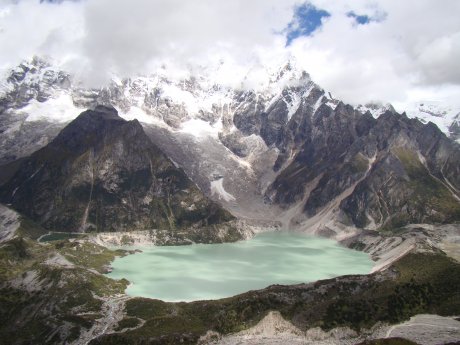The number of glacier lakes on the Tibetan plateau and surrounding mountain ranges has grown significantly over the past three decades because of melting glaciers, a new study has revealed, warning of the growing risk of catastrophic floods downstream.
The Hindu Kush Himalayan region – also known as the world’s third pole because it holds the largest store of permanent ice outside the poles – is warming faster than the global average under climate change. As ice turns to water; glaciers are slowly reduced to lakes.
Researchers from the Institute of Tibetan Plateau Research at the Chinese Academy of Sciences used land and satellite imagery to track glacier lakes in what is the first inventory of the entire third pole region – which stretches across the Pamirs, Hindu Kush-Karakoram Himalayas and the Tibetan Plateau.
The new research published in Global and Planetary Change presents an important database and basis for long-term monitoring and evaluation future flood disasters.
The team found that the number of glacier lakes has grown from 4,602 in 1990, to 4,981 in 2000 and then to 5,701 by 2010. Existing lakes have also expanded – rising on average by 21 cm a year from 2003 to 2009.
The study concludes glacier and snow melt and increased rainfall is expanding the lakes. Disappearing permafrost – perennial layers of frozen soil that has turned into ice – may also play a part.
Lakes have expanded faster in the eastern Himalayas – in Bhutan, around Mount Everest and western Nepal – where glaciers have been melting faster. China’s second glacier inventory published earlier this year showed glaciers have shrunk by 18% since the 1970s.
Most of the lakes are located in the Brahmaputra (39%), Indus (28%) and Amu Darya (10%) basins, where there is less snowfall and higher rainfall during the monsoon.
The findings are consistent with global warming and fast glacier retreat, said Zhang Guoqing, associate professor at the Institute of Tibetan Plateau Research and lead author of the paper. What surprised the team was that glacier lakes in the Karakoram Range – along the borders of Pakistan, India and China – have also grown, even though scientists say glaciers here are stable or expanding, Zhang told thethirdpole.net.
Similar trends
Other studies – which have focused on individual countries, particularly Nepal and Bhutan – have revealed similar trends. The infamous Imja Lake in Nepal is growing at a rate of 47 metres a year. Rongbuk glacier on Mount Qomolangma increased 13 times between 1974 and 2009.
Pradeep Mool, who is leading research on glacier lakes at the International Centre for Integrated Mountain Development (ICIMOD) in Kathmandu, estimates the number of glacier lakes in the region may be far higher.
His team will publish its region-wide inventory of glacier lakes later this year. They also use landsat data, but while the Chinese team defined glacier lakes as being within 10 km of glacier snouts, ICIMOD includes lakes further away.
An earlier ICIMOD study estimated there are 8,000 glacier lakes in the region, with over 1,400 lakes in Nepal alone.
Disasters in the making
Glacier lakes are high-altitude disasters in the making. If a lake breaks through its walls of glacial debris, known as moraine, it could release a deluge of water, mud and rock up to 90 km away. This would swamp homes and fields with a layer of rubble up to 15 metres thick, leading to the loss of the land for a generation. Given the current rate of glacier melt, the question is when, rather than if.
There have been 50 reported glacial lake outbursts since the 1930s, said Mool. The worst disaster was the 1981 Cirenmaco glacier lake flood, which killed 200 people and washed away the China-Nepal Friendship Bridge, resulting in US$3 million worth of damage. Now satellite data is showing the lake is full to the brim again – a sudden rise in temperature or earthquake could cause this to burst.
Further field work is urgently needed to evaluate the risks of glacial lake outburst floods (also known as GLOFs) in the Himalayas, said Zhang, particularly in light of the devastating earthquakes that hit Nepal in April this year.
Experts inspected several glacial lakes after the quake and found they were safe at the moment.
At the end of June an earthquake in India shattered the Lemthang Tsho glacier lake in Bhutan, sweeping away roads and agricultural land. In this case, government awareness campaigns and early warning systems paid off; there were no casualties – though a group of mushroom pickers were stranded and people had to be evacuated from the large Punatsangchu hydropower dam.

